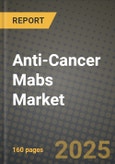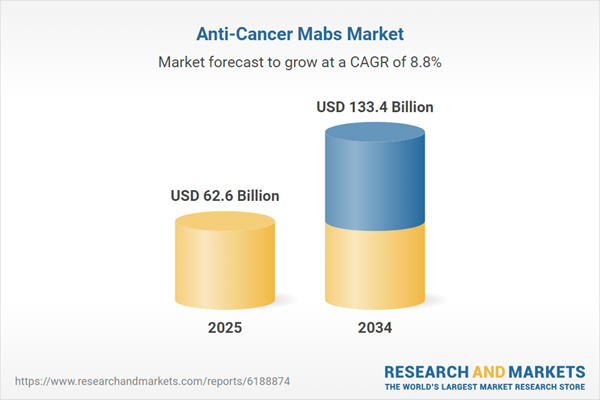The Anti-Cancer Monoclonal Antibodies (MAbS) Market is a significant segment of the oncology therapeutics market, focusing on the development and commercialization of monoclonal antibody-based cancer therapies. These MAbs are designed to target specific antigens on cancer cells, triggering an immune response or blocking tumor growth. The market is driven by the increasing prevalence of cancer and the demand for targeted therapies with improved efficacy and safety profiles. The market encompasses various MAb classes, including naked antibodies, conjugated antibodies, and bispecific antibodies.
The market is segmented based on target antigen, application, and region. The major target antigens include HER2, EGFR, and PD-1. The market caters to a diverse range of cancer types, including breast cancer, lung cancer, and colorectal cancer. The market is characterized by intense competition among pharmaceutical and biotechnology companies, with a focus on developing novel MAbs and expanding Therapeutic applications of existing MAbs.
The Anti-Cancer MAbS Market is subject to stringent regulatory requirements and evolving guidelines regarding cancer therapies. The market is also influenced by the increasing complexity of cancer biology and the need for highly specific and potent MAbs. The market is expected to continue its growth trajectory, driven by the increasing demand for targeted cancer therapies and the development of innovative MAb technologies.
Key Insights: Anti-Cancer Mabs Market
Development of novel MAb platforms with improved efficacy and safety profiles.Expansion of MAb applications to solid tumors and other cancer types.
Increasing use of biomarker-driven patient selection for MAb therapy.
Growing interest in combination therapies involving MAbs and other cancer treatments.
Rising adoption of next-generation sequencing and other technologies to optimize MAb development.
Increasing prevalence of cancer and the need for effective treatments.
Growing demand for targeted cancer therapies with improved safety profiles.
Technological advancements in MAb development and conjugation technologies.
Rising investment in research and development by pharmaceutical and biotechnology companies.
Increasing availability of funding and partnerships for MAb development projects.
High cost of MAb development and manufacturing.
Complexity of MAb design and optimization.
Challenges in delivering the payload to cancer cells and minimizing off-target effects.
Evolving regulatory requirements and intellectual
Anti-Cancer Mabs Market Segmentation
By Type
- Murine Antibodies
- Chimeric Antibodies
- Humanized Antibodies
- Other Types
By Application
- Blood Cancer
- Breast Cancer
- Lung Cancer
- Melanoma
- Colorectal Cancer
- Liver Cancer
- Other Applications
By End User
- Hospitals
- Research Institutes
- Other End Users
Key Companies Analysed
- Amgen Inc.
- Bristol Myers Squibb Company
- Eli Lilly and Company
- F. Hoffmann-La Roche Ltd.
- GlaxoSmithKline plc
- Johnson & Johnson
- Novartis AG
- Merck & Co. Inc.
- Spectrum Pharmaceuticals Inc.
- AstraZeneca plc.
- Pfizer Inc.
- Gilead Sciences Inc.
- Bayer HealthCare
- ImmunoGen Inc.
- Genentech Inc.
- AbbVie Inc.
- Takeda Pharmaceuticals
- Seattle Genetics
- Regeneron Pharmaceuticals
- Celgene
- Ipsen
- Daiichi Sankyo
- Kite Pharma
- ADC Therapeutics
- MacroGenics Inc.
- BioXcel Therapeutics
- Zymeworks Inc.
- Exelixis Inc.
- Blueprint Medicines
- Erytech Pharma
- Oncopeptides AB.
Anti-Cancer Mabs Market Analytics
The report employs rigorous tools, including Porter’s Five Forces, value chain mapping, and scenario-based modeling, to assess supply-demand dynamics. Cross-sector influences from parent, derived, and substitute markets are evaluated to identify risks and opportunities. Trade and pricing analytics provide an up-to-date view of international flows, including leading exporters, importers, and regional price trends.Macroeconomic indicators, policy frameworks such as carbon pricing and energy security strategies, and evolving consumer behavior are considered in forecasting scenarios. Recent deal flows, partnerships, and technology innovations are incorporated to assess their impact on future market performance.
Anti-Cancer Mabs Market Competitive Intelligence
The competitive landscape is mapped through proprietary frameworks, profiling leading companies with details on business models, product portfolios, financial performance, and strategic initiatives. Key developments such as mergers & acquisitions, technology collaborations, investment inflows, and regional expansions are analyzed for their competitive impact. The report also identifies emerging players and innovative startups contributing to market disruption.Regional insights highlight the most promising investment destinations, regulatory landscapes, and evolving partnerships across energy and industrial corridors.
Countries Covered
- North America - Anti-Cancer Mabs market data and outlook to 2034
- United States
- Canada
- Mexico
- Europe - Anti-Cancer Mabs market data and outlook to 2034
- Germany
- United Kingdom
- France
- Italy
- Spain
- BeNeLux
- Russia
- Sweden
- Asia-Pacific - Anti-Cancer Mabs market data and outlook to 2034
- China
- Japan
- India
- South Korea
- Australia
- Indonesia
- Malaysia
- Vietnam
- Middle East and Africa - Anti-Cancer Mabs market data and outlook to 2034
- Saudi Arabia
- South Africa
- Iran
- UAE
- Egypt
- South and Central America - Anti-Cancer Mabs market data and outlook to 2034
- Brazil
- Argentina
- Chile
- Peru
Research Methodology
This study combines primary inputs from industry experts across the Anti-Cancer Mabs value chain with secondary data from associations, government publications, trade databases, and company disclosures. Proprietary modeling techniques, including data triangulation, statistical correlation, and scenario planning, are applied to deliver reliable market sizing and forecasting.Key Questions Addressed
- What is the current and forecast market size of the Anti-Cancer Mabs industry at global, regional, and country levels?
- Which types, applications, and technologies present the highest growth potential?
- How are supply chains adapting to geopolitical and economic shocks?
- What role do policy frameworks, trade flows, and sustainability targets play in shaping demand?
- Who are the leading players, and how are their strategies evolving in the face of global uncertainty?
- Which regional “hotspots” and customer segments will outpace the market, and what go-to-market and partnership models best support entry and expansion?
- Where are the most investable opportunities - across technology roadmaps, sustainability-linked innovation, and M&A - and what is the best segment to invest over the next 3-5 years?
Your Key Takeaways from the Anti-Cancer Mabs Market Report
- Global Anti-Cancer Mabs market size and growth projections (CAGR), 2024-2034
- Impact of Russia-Ukraine, Israel-Palestine, and Hamas conflicts on Anti-Cancer Mabs trade, costs, and supply chains
- Anti-Cancer Mabs market size, share, and outlook across 5 regions and 27 countries, 2023-2034
- Anti-Cancer Mabs market size, CAGR, and market share of key products, applications, and end-user verticals, 2023-2034
- Short- and long-term Anti-Cancer Mabs market trends, drivers, restraints, and opportunities
- Porter’s Five Forces analysis, technological developments, and Anti-Cancer Mabs supply chain analysis
- Anti-Cancer Mabs trade analysis, Anti-Cancer Mabs market price analysis, and Anti-Cancer Mabs supply/demand dynamics
- Profiles of 5 leading companies - overview, key strategies, financials, and products
- Latest Anti-Cancer Mabs market news and developments
Additional Support
With the purchase of this report, you will receive:- An updated PDF report and an MS Excel data workbook containing all market tables and figures for easy analysis.
- 7-day post-sale analyst support for clarifications and in-scope supplementary data, ensuring the deliverable aligns precisely with your requirements.
- Complimentary report update to incorporate the latest available data and the impact of recent market developments.
This product will be delivered within 1-3 business days.
Table of Contents
Companies Mentioned
- Amgen Inc.
- Bristol Myers Squibb Company
- Eli Lilly and Company
- F. Hoffmann-La Roche Ltd.
- GlaxoSmithKline PLC
- Johnson & Johnson
- Novartis AG
- Merck & Co. Inc.
- Spectrum Pharmaceuticals Inc.
- AstraZeneca PLC
- Pfizer Inc.
- Gilead Sciences Inc.
- Bayer HealthCare
- ImmunoGen Inc.
- Genentech Inc.
- AbbVie Inc.
- Takeda Pharmaceuticals
- Seattle Genetics
- Regeneron Pharmaceuticals
- Celgene
- Ipsen
- Daiichi Sankyo
- Kite Pharma
- ADC Therapeutics
- MacroGenics Inc.
- BioXcel Therapeutics
- Zymeworks Inc.
- Exelixis Inc.
- Blueprint Medicines
- Erytech Pharma
- Oncopeptides AB .
Table Information
| Report Attribute | Details |
|---|---|
| No. of Pages | 160 |
| Published | October 2025 |
| Forecast Period | 2025 - 2034 |
| Estimated Market Value ( USD | $ 62.6 Billion |
| Forecasted Market Value ( USD | $ 133.4 Billion |
| Compound Annual Growth Rate | 8.7% |
| Regions Covered | Global |
| No. of Companies Mentioned | 31 |









